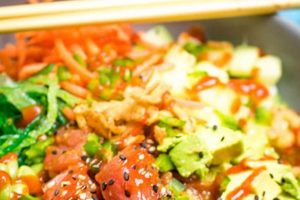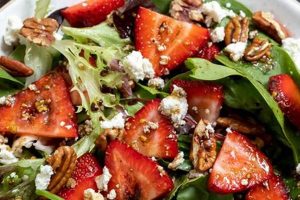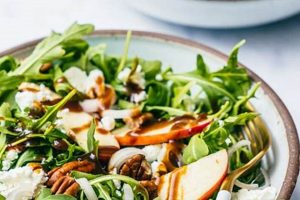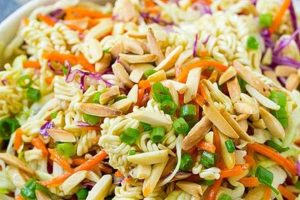This dish combines shredded carrots, raisins, and pineapple chunks, often bound with a creamy dressing, typically mayonnaise-based. Variations can include nuts, such as walnuts or pecans, and sometimes shredded coconut. A simple version might involve just the three core ingredients and a dressing of mayonnaise and a touch of sweetener. More complex versions might incorporate yogurt or sour cream into the dressing and spices like cinnamon or ginger.
The sweetness of the pineapple and raisins complements the earthiness of the carrots, creating a balanced flavor profile. The textural contrast between the crunchy carrots, chewy raisins, and juicy pineapple adds to the appeal. This type of salad offers a good source of vitamins, minerals, and fiber. Historically, such salads gained popularity as a refreshing and readily available side dish, particularly in potluck settings. Their ease of preparation and adaptability to seasonal ingredients contributed to their widespread adoption.
This discussion will delve further into various aspects of this dish, including variations in ingredients and dressings, nutritional benefits, tips for preparation and storage, and potential adaptations for specific dietary needs.
Tips for a Perfect Carrot Raisin Salad with Pineapple
Optimizing ingredient preparation and incorporating thoughtful additions can elevate this simple salad to a delightful culinary experience. Attention to detail ensures a balanced flavor profile and pleasing texture.
Tip 1: Grate carrots finely for optimal texture. A fine grate provides a more delicate texture and allows the dressing to coat the carrots evenly.
Tip 2: Plump the raisins for enhanced flavor and juiciness. Briefly soaking raisins in hot water or pineapple juice softens them and intensifies their sweetness.
Tip 3: Use fresh pineapple for the best flavor. Canned pineapple can be used, but fresh pineapple offers a brighter, more vibrant taste. Ensure the pineapple is ripe but not overripe.
Tip 4: Balance sweetness and tanginess in the dressing. Adjust the amount of sweetener in the dressing based on the sweetness of the pineapple. A touch of acidity, such as lemon juice or apple cider vinegar, can enhance the flavor.
Tip 5: Incorporate nuts or seeds for added crunch and nutritional value. Walnuts, pecans, or sunflower seeds provide a textural contrast and boost the salad’s nutritional profile.
Tip 6: Chill the salad before serving. Chilling allows the flavors to meld and enhances the refreshing quality of the salad.
Tip 7: Don’t overmix the salad. Gently combine the ingredients to avoid crushing the carrots or pineapple.
By following these suggestions, one can create a carrot raisin salad with pineapple that is both flavorful and visually appealing. These techniques ensure a harmonious balance of textures and tastes, resulting in a truly satisfying dish.
With these tips in mind, the following section offers a collection of recipe variations to explore and enjoy.
1. Ingredients
Ingredient selection significantly influences the final flavor profile and nutritional value of a carrot raisin salad with pineapple. Careful consideration of each component ensures a balanced and enjoyable dish. The following facets explore key ingredient categories and their impact on the overall quality of the salad.
- Core Ingredients
These form the foundation of the salad and typically include carrots, raisins, and pineapple. Carrots provide sweetness and crunch. Raisins offer chewiness and concentrated sweetness. Pineapple contributes tanginess and juiciness. The quality and freshness of these core ingredients directly affect the overall taste and texture.
- Dressing
The dressing binds the ingredients and adds flavor complexity. Mayonnaise-based dressings are common, often incorporating sweeteners and acidic elements. Variations can include yogurt, sour cream, or lighter vinaigrette-style dressings. The dressing’s consistency and flavor significantly impact the salad’s overall palatability.
- Optional Additions
These enhance the flavor, texture, and nutritional value. Nuts, such as walnuts or pecans, provide crunch and healthy fats. Shredded coconut adds sweetness and texture. Other additions might include spices like cinnamon or ginger, or chopped fresh herbs. Optional ingredients provide opportunities for customization and creativity.
- Sweeteners
Sweeteners balance the tartness of the pineapple and enhance the overall sweetness of the salad. Granulated sugar, honey, maple syrup, or agave nectar are common choices. The type and amount of sweetener influence the final flavor profile and calorie content. Artificial sweeteners can be used for dietary considerations.
The interplay of these ingredient categories contributes to the distinctive character of a carrot raisin salad with pineapple. Thoughtful ingredient selection and preparation are crucial for creating a well-balanced and flavorful dish. Understanding the role of each component allows for greater control over the final outcome and enables customization to suit individual preferences and dietary needs.
2. Preparation
Preparation methods significantly influence the final quality of carrot raisin salad with pineapple. Proper techniques enhance flavor, texture, and overall appeal. Attention to detail in each preparatory step ensures a well-balanced and enjoyable culinary experience.
- Carrot Preparation
Grating carrots provides the desired texture and surface area for optimal dressing adhesion. Finely grated carrots offer a more delicate texture, while coarser grating yields a more substantial bite. Uniformity in grating size ensures even cooking and flavor distribution.
- Raisin Preparation
Soaking raisins in hot water or juice plumps them, intensifying their sweetness and improving their texture. This process rehydrates the raisins, making them more succulent and flavorful. The choice of soaking liquid can further enhance the flavor profile of the salad, aligning with complementary flavors like pineapple juice.
- Pineapple Preparation
Selecting ripe, fresh pineapple offers the best flavor and texture. Canned pineapple can be used as a substitute, but fresh pineapple provides a brighter, more vibrant taste. Properly cutting and coring the pineapple ensures even bite-sized pieces that blend seamlessly with the other ingredients.
- Dressing Preparation
Thorough mixing of dressing ingredients ensures uniform flavor distribution. Emulsification, where applicable, creates a stable and creamy texture. Adjusting sweetness and tanginess to complement the other ingredients creates a balanced flavor profile.
These preparatory steps contribute significantly to the overall success of the dish. Careful execution of each step enhances the flavor, texture, and visual appeal of the carrot raisin salad with pineapple. By understanding the impact of these techniques, one can create a consistently delicious and satisfying salad.
3. Flavor Balance
Flavor balance is crucial for a successful carrot raisin salad with pineapple. The inherent sweetness of raisins and pineapple requires careful counterpoint. Excessive sweetness can be cloying; thus, balancing it with acidity is essential. This balance prevents the salad from becoming one-dimensional and allows the individual flavors to shine. A well-balanced salad features a harmonious interplay of sweet, tart, and subtly earthy notes from the carrots.
For example, a dressing heavy on mayonnaise might require more acidity from lemon juice or vinegar to cut through the richness and complement the sweetness of the fruit. Conversely, a lighter dressing based on yogurt might necessitate less acid. Consider the sweetness of the pineapple itself; riper pineapples will require a more assertive acidic counterpoint in the dressing. Adding a pinch of salt further enhances the other flavors and creates a more complex profile. This interplay of contrasting flavors contributes significantly to the overall enjoyment of the salad.
Achieving optimal flavor balance elevates the carrot raisin salad with pineapple from a simple side dish to a more sophisticated culinary creation. Understanding the interaction of sweet, tart, and savory elements allows for precise control over the final taste profile. This knowledge enables adaptation of recipes to personal preference and ingredient availability, guaranteeing a consistently delicious and satisfying result. The interplay of these flavors, when properly balanced, creates a dynamic and refreshing culinary experience.
4. Texture Contrast
Texture contrast significantly contributes to the sensory appeal of a carrot raisin salad with pineapple. The interplay of various textures creates a more dynamic and engaging eating experience. A successful salad balances contrasting textures to offer complexity and prevent monotony. This discussion explores the various textural elements within this specific salad and their combined effect.
- Crunchy Carrots
The crisp, firm texture of grated carrots provides a foundation of contrasting texture. This element offers a satisfying bite and acts as a counterpoint to the softer elements within the salad. Proper grating technique is crucial; too coarse, and the carrots might overpower the other textures; too fine, and they might lack presence.
- Chewy Raisins
Raisins offer a chewy texture that contrasts with both the crunch of the carrots and the juiciness of the pineapple. Plumping the raisins enhances their chewiness and ensures they integrate seamlessly with the other textures. Their slightly sticky consistency also contributes to the overall textural complexity.
- Juicy Pineapple
The succulent, juicy texture of pineapple provides a refreshing contrast to the drier components of the salad. Its tender yet slightly fibrous consistency adds another layer of textural interest. Fresh pineapple generally offers a superior textural experience compared to canned pineapple.
- Creamy Dressing
The dressing, often mayonnaise-based, coats the ingredients and adds a creamy, smooth texture that binds the other elements together. The consistency of the dressing plays a vital role; too thick, and it might overwhelm the other textures; too thin, and it might fail to create a cohesive salad.
The interplay of these contrasting texturescrunchy, chewy, juicy, and creamycreates a dynamic and satisfying sensory experience. This balance prevents the salad from becoming texturally one-dimensional and adds to its overall appeal. The thoughtful combination of these elements distinguishes a well-made carrot raisin salad with pineapple and contributes significantly to its enjoyment.
5. Nutritional Value
Nutritional value represents a significant aspect of carrot raisin salad with pineapple. This dish offers more than just a pleasing combination of flavors and textures; it provides essential vitamins, minerals, and dietary fiber. Understanding the nutritional composition allows for informed dietary choices and highlights the potential health benefits associated with consuming this salad.
- Vitamins and Minerals from Carrots
Carrots are a rich source of beta-carotene, a precursor to vitamin A, which plays a vital role in vision health, immune function, and cell growth. They also provide potassium, an essential mineral for maintaining fluid balance and blood pressure regulation. The vitamin K content in carrots contributes to blood clotting and bone health.
- Fiber and Iron from Raisins
Raisins contribute dietary fiber, promoting digestive health and regularity. They also offer a source of iron, crucial for red blood cell production and oxygen transport throughout the body. While raisins are naturally high in sugar, their fiber content helps mitigate the impact on blood sugar levels.
- Vitamin C and Bromelain from Pineapple
Pineapple is a good source of vitamin C, a potent antioxidant that supports immune function and collagen production. It also contains bromelain, an enzyme with potential anti-inflammatory properties. Bromelain may aid in digestion and reduce muscle soreness.
- Impact of Dressing and Added Ingredients
The nutritional profile of the salad can be influenced by the type of dressing and any additional ingredients. Mayonnaise-based dressings contribute fat and calories, while yogurt-based dressings offer protein and probiotics. Nuts and seeds add healthy fats, fiber, and additional vitamins and minerals. Careful consideration of these additions allows for optimization of the salad’s nutritional value.
Consuming carrot raisin salad with pineapple offers a combination of essential nutrients that contribute to overall health and well-being. While the specific nutritional content can vary based on the recipe and ingredient choices, the core components of this salad offer a valuable source of vitamins, minerals, and fiber. Incorporating this salad as part of a balanced diet can contribute to improved nutritional intake and support various bodily functions. Understanding the individual contributions of each ingredient empowers individuals to make informed dietary choices and maximize the potential health benefits of this simple yet nutritious dish.
6. Serving Suggestions
Serving suggestions enhance the versatility of carrot raisin salad with pineapple, transforming it from a simple side dish to a component of diverse culinary applications. Consideration of complementary flavors and textures allows for integration into various meal structures and occasions, expanding the potential of this dish beyond its traditional role.
- As a Side Dish
The salad’s sweet and tangy profile complements a wide range of main courses. It pairs well with grilled meats, roasted poultry, and fish. The refreshing nature of the salad provides a counterpoint to richer, savory dishes. In this context, the salad serves as a palate cleanser and adds a bright element to the meal.
- Within a Larger Buffet or Potluck
Its ease of preparation and transportability make this salad a practical choice for potlucks and buffets. The vibrant colors and varied textures contribute visual appeal to a spread of dishes. The salad’s make-ahead nature allows for convenient serving in these settings.
- Incorporated into Sandwiches or Wraps
The salad can add a burst of flavor and texture to sandwiches or wraps. Its sweetness and crunch complement savory fillings. This application provides a creative alternative to traditional sandwich components and introduces a unique textural dimension.
- As a Topping for Grilled or Roasted Foods
The salad can serve as a flavorful and visually appealing topping for grilled chicken, fish, or tofu. The contrasting textures and temperatures create a dynamic culinary experience. This application adds a layer of complexity to the main dish and elevates its presentation.
These varied serving suggestions demonstrate the adaptability of carrot raisin salad with pineapple. Understanding its complementary flavors and textures allows for creative integration into a broader range of culinary contexts. This versatility enhances the appeal of the salad and expands its potential beyond a simple side dish. From casual meals to more formal occasions, this dish offers a refreshing and flavorful addition to a diverse array of culinary experiences.
Frequently Asked Questions
This section addresses common inquiries regarding carrot raisin salad with pineapple, providing clear and concise information to ensure optimal preparation and enjoyment.
Question 1: What is the best way to prevent the salad from becoming watery?
Excess moisture can result from juicy pineapple or insufficiently drained raisins. Thoroughly draining both ingredients before combining them with the other components helps maintain the desired texture. Additionally, chilling the salad allows the flavors to meld without excess moisture accumulation.
Question 2: Can alternative sweeteners be used in the dressing?
Honey, maple syrup, or agave nectar offer suitable alternatives to granulated sugar. Artificial sweeteners can also be used for dietary considerations. The chosen sweetener will influence the final flavor profile and calorie content. Careful adjustment based on the sweetness of the pineapple is recommended.
Question 3: How long can the salad be stored in the refrigerator?
Properly stored in an airtight container, the salad typically remains fresh for up to three days in the refrigerator. However, the texture of the carrots and raisins may soften slightly over time. Consuming the salad within two days generally provides the optimal textural experience.
Question 4: Can this salad be frozen?
Freezing is not recommended. The water content in the pineapple and dressing can cause undesirable textural changes upon thawing. Freezing can also negatively impact the crispness of the carrots and the overall flavor balance of the salad.
Question 5: Can canned pineapple be used instead of fresh?
While fresh pineapple offers superior flavor and texture, canned pineapple can be substituted if necessary. Ensure the canned pineapple is packed in juice, not syrup, and drain thoroughly before incorporating it into the salad. Fresh pineapple contributes a brighter, more vibrant flavor profile.
Question 6: How can the nutritional value of the salad be maximized?
Incorporating a variety of nuts and seeds boosts the salad’s healthy fat, fiber, and vitamin/mineral content. Using a yogurt-based dressing instead of a mayonnaise-based dressing increases protein and probiotics. These additions further enhance the nutritional density of the dish while maintaining its flavor profile.
Addressing these common inquiries helps ensure a successful and enjoyable experience with carrot raisin salad with pineapple. Understanding these aspects allows for informed choices regarding ingredient selection, preparation methods, and storage techniques.
For further exploration, the following section delves into variations and adaptations of this versatile dish.
Carrot Raisin Salad Recipe with Pineapple
Exploration of this dish reveals a deceptively simple composition yielding a complex interplay of flavors and textures. Careful ingredient selection, precise preparation techniques, and attention to flavor balance contribute significantly to the final product. Nutritional considerations highlight the dish’s potential health benefits derived from the inherent properties of core ingredients: carrots, raisins, and pineapple. Furthermore, the adaptability of this salad extends beyond its traditional role as a side dish, offering versatility in various culinary applications.
This exploration underscores the potential for culinary creativity within seemingly simple dishes. Thoughtful consideration of ingredient combinations and preparation methods elevates everyday fare to a more nuanced level of dining experience. Continued experimentation with flavor profiles and presentation expands the possibilities of this classic salad, promising ongoing enjoyment and culinary discovery.






